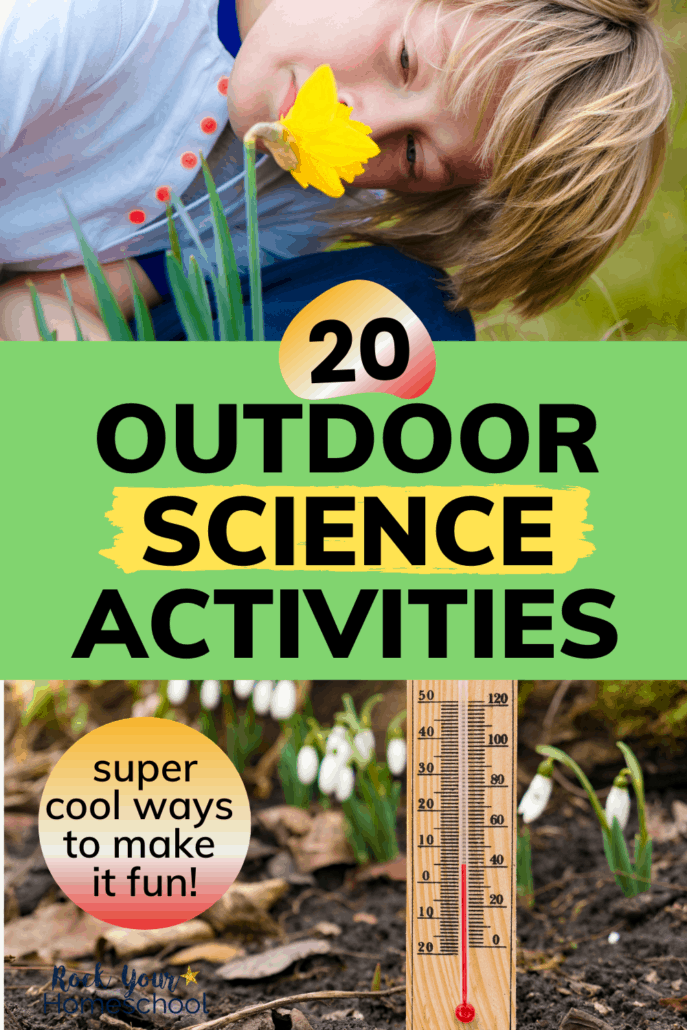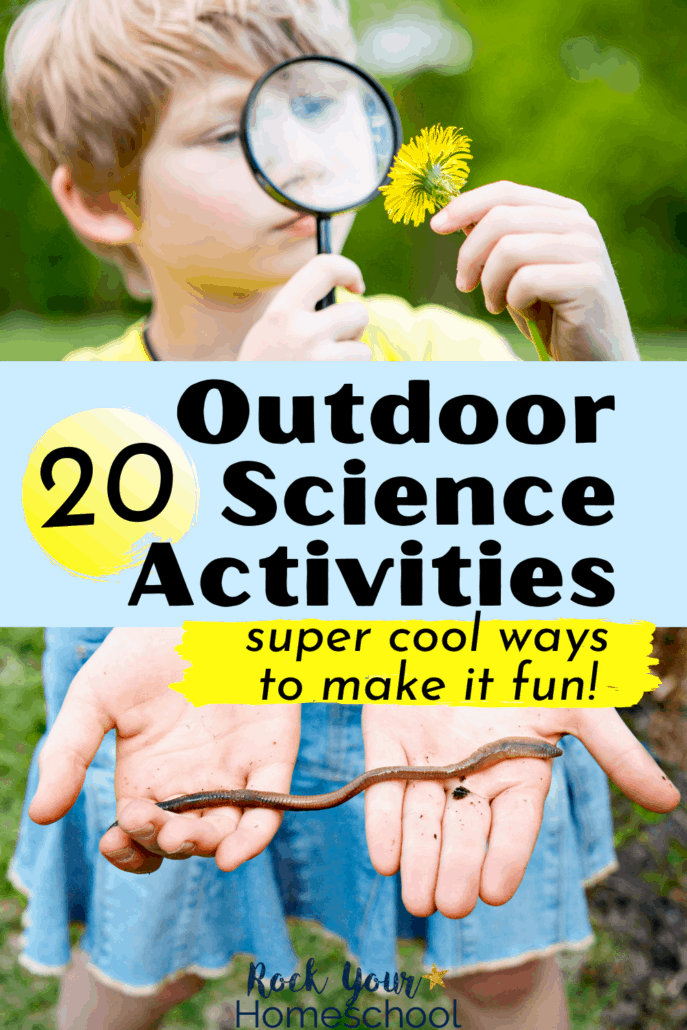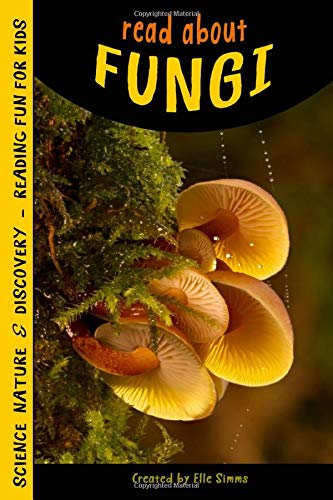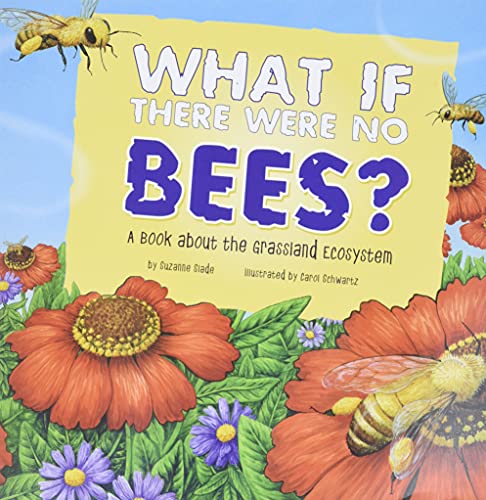20 Super Cool and Fun Outdoor Science Activities Your Kids Will Love
This post may contain affiliate links. Please read my disclosure statement. Thanks for visiting!
Outdoor science activities are awesome ways to boost learning and enjoy new experiences.
Your kids will get so excited about taking your learning adventures outside.
And you'll appreciate keeping your house clean 😉
Check out our 20 favorite ways to bring science fun outdoors for experiments and more!

Why Outdoor Science Activities ROCK!
One of the best places to learn about the world AND science is outside. The outdoors is science, after all!
There are so many different outdoor science activities that your kids will love and find fascinating.
And you'll be doing a happy dance that your kitchen isn't turned into a disaster area!
My boys and I love to get outside every day - and make the most of that special time. And that definitely includes science fun.
From gardening to watching for shooting stars, getting your kids outside teaches all kinds of science lessons from real-life learning.
Let’s look at some of the best outdoor science activities that your kids and you will love.

20 Outstanding Outdoor Science Activities
1. Plant a Garden
One of the most fun outdoor science activities is to plant a garden.
Planting a garden teaches adults and kids so much about the world around them.
And if you grow herbs and vegetables, it introduces your children to healthy new foods to try.
Kids are far more likely to try new foods if they grew them in their garden.
Let's Get Growing! Sustainable Gardening for Kids - Children's Conservation BooksGardening for Kids: 35 nature activities to sow, grow, and makeGardening For Kids: Educational Activities & Journal For ChildrenThe Best-Ever Step-by-Step Kid's First Gardening: Fantastic Gardening Ideas For 5 To 12 Year-Olds, From Growing Fruit And Vegetables And Fun With Flowers To Wildlife Gardening And Outdoor CraftsGardening for Kids: Learn, Grow, and Get Messy with Fun STEAM ProjectsGardening Lab for Kids: 52 Fun Experiments to Learn, Grow, Harvest, Make, Play, and Enjoy Your Garden (Lab for Kids, 24)
2. Study the Plant Life Cycle
When your kids spend time outside in the garden, it's an excellent opportunity to teach them about the plant life cycle.
Start with planting a seed. Show your children how to plant them in a pot or your garden bed. Water the seeds and watch them grow.
Or you can sprout seeds in a sandwich bag with a damp paper towel and tape to a window. Such a cool experience watching the roots grow!
Later, you’ll be able to show your child how the plant produces seeds at the end that you can plant the following year.
Seed to Plant (Rookie Read-About Science: Life Cycles)The Amazing Life Cycle of Plants (Look and Wonder)Plant Life Cycles (My Science Library)Plant Life Cycles (A True Book: Incredible Plants!)From Seed to Plant
3. Observe or Dig Up Earthworms
My boys love discovering earthworms! We get a TON of them on our paved driveway on a rainy day.
It’s such a fun educational outdoor activity.
If your kids are interested in worms, consider making a worm farm to watch them dig through the soil.
After your kids dig up the earthworms, take time to draw the worm to the best of your ability.
Kids love this activity so make sure you have plenty of art supplies with you.
Once your child diagrams the worm, you can label the parts of the worm and learn why worms are vital for our earth.
* If you have older kids who need to do dissection for high school science, check out this earthworm kit from Home Science Tools.
Earthworm (Life Cycle of A...(Paperback))It's a Good Thing There Are Earthworms (Rookie Read-About Science: It's a Good Thing...)Facts About the Earthworm (A Picture Book For Kids)An Earthworm's Life (Nature Upclose)Let's Look at Earthworms (Lightning Bolt Books: Animal Close-Ups (Paperback))
4. Start to Compost
Here's another outdoor science activity that teaches kids about cycles throughout nature. And you can use the compost later when you garden (see above).
Make a compost bin together and start collecting compost-safe items.
Each day, have your child take items out to the compost and turn it.
In a few months, your child will see how all of the organic materials added turn into compost which naturally happens.
Green Machine: The Slightly Gross Truth about Turning Your Food Scraps into Green EnergyComposting For Beginners: The Complete Guide to Start Your Composting With the Ultimate Eco-Friendly and Low Cost TechniquesCompost Stew: An A to Z Recipe for the EarthComposting: Nature's Recyclers (Amazing Science)A Green Kid's Guide to Composting (A Green Kid's Guide to Gardening!)
5. Measure the Root Ball of a Tree
Find mature trees with roots that pop up above the ground.
Take the cord and have your kids measure around the trees’ roots.
If you have several trees, you can measure several trees and compare them to see the largest trees.
6. Find Different Leaves and Identify the Trees
A popular outdoor science activity is collecting different leaves and identifying the tree that they came from.
Record all of the leaves that you find. Create a journal of leaves from all the types of trees in your area.
The Tree Book for Kids and Their Grown-UpsTrees, Leaves, Flowers and Seeds: A Visual Encyclopedia of the Plant Kingdom (Smithsonian)National Geographic Field Guide to the Trees of North America: The Essential Identification Guide for Novice and ExpertTrees, Leaves & Bark (Take Along Guides)Ultimate Explorer Field Guide: Trees
7. Study Evergreen vs. Deciduous Trees
Another awesome activity to enjoy while outside with your kids is the difference between evergreen and deciduous trees.
Talk about the difference between these different types of trees.
Then, study the same trees - one of each - throughout the year. Watch how the deciduous tree loses its leaves while the evergreen doesn’t. Fantastic observation activities!
8. Learn About Wildflowers in Your Area
Wildflowers are so beautiful!
In the spring and summer, most areas have unique flowers that grow everywhere.
Take time with your kids to learn the native wildflowers in your area and ID them.
Oh, and Wildcraft is a super fun game you can enjoy year-round!

Ultimate Explorer Field Guide: WildflowersWildflowers, Blooms & Blossoms (Take Along Guides)Wildflowers (National Geographic: My First Pocket Guide)
9. Observe the Same Tree for All 4 Seasons
This is a spectacular yet straightforward outdoor science activity.
Pick a tree, preferably one that is in your backyard or easily accessible.
Draw, paint, or photograph the tree each season throughout the year, documenting and noting the tree’s changes. Wonderful way to incorporate art into your science fun!
10. Walk-in a Creek and See What You Find
Kids love walking in creeks. And creeks are full of fun things to discover.
You may find minnows, salamanders, tadpoles, crawdads, or other exciting creatures.
Oh, and make sure you have nets for your kids!
11. Look for Mushrooms and Identify Them
Going on a search for mushrooms might seem like a strange idea, but kids often think that mushrooms are edible.
Educating kids from a young age that they should never eat a mushroom without proper identification is essential.
Start by taking pictures and drawing all the mushrooms you find.
Then, take the time to find the name of the mushroom and determine if it’s edible or not.
Also, learn what mushrooms need to grow.
Another awesome science activity is to use a mushroom growing kit at home to learn how to grow them!

Read About Fungi - Reading Fun for Kids (Read About Books) (Volume 4)Mushroom Identification Book For Kids: Notebook For Mushroom Hunters - Mushroom Lovers Journal - Mushroom Hunting Log Book Full Of Detail (Keeps Track ... Stalk Characteristics and much more)Mushroom Hunting Log Book for Kids: Mushroom Picking guided journal & notebook – Gift for little Mushroom HuntersNational Audubon Society Pocket Guide: Familiar Mushrooms (National Audubon Society Pocket Guides)Foraging: This book includes: Recognizing Toxic and Poisonous Wild Plants and Mushrooms + The Best Edible Wild Foods Recipes + Eating for Free while on Hiking and Camping
12. Search for Moss
Moss is always fun to find. And it grows differently than other plants.
Moss grows and spreads by spores.
Young kids enjoy finding moss and feeling the texture.
Older kids can also study how it grows and what type of environment it prefers.
Moss: From Forest to Garden: A Guide to the Hidden World of MossMosses, Liverworts, and Hornworts: A Field Guide to the Common Bryophytes of the Northeast
13. Observe the Moon
Get a telescope and start to observe the moon. This affordable desktop telescope has been perfect for my boys.
You can do this any month of the year, so grab a nature journal and pick several days throughout the month when you’ll observe the moon with your kids.
Oh, and take the time to learn the name of each phase of the moon so you're all set for outdoor science fun!
The Moon Book (New & Updated Edition)Sky Gazing: A Guide to the Moon, Sun, Planets, Stars, Eclipses, and Constellations50 Things To See With A Telescope - Kids: A Constellation Focused Approach
14. Map the Constellations
Constellations are so much fun to learn. My boys think this activity is one of the best outdoor science learning adventures!
Start with the most common constellations and use a telescope to find them. Diagram what you see.
Later, use marshmallows and toothpicks to recreate the constellations.
These FREE constellation cards are excellent ways to boost your learning fun.
15. Track the Weather
Create a weather journal for your entire school year (or maybe a month or week 😉).
Each day, your kids have to find out the temperature and describe the weather they see outside.
Wonderful way to encourage your kids to build observation and description skills!
National Geographic Little Kids First Big Book of Weather (National Geographic Little Kids First Big Books)WeatherThe Big Book of Weather: A Look at How Things Work for KidsNational Geographic Kids Everything Weather: Facts, Photos, and Fun that Will Blow You AwayField Guide to the Weather: Learn to Identify Clouds and Storms, Forecast the Weather, and Stay SafeThe Everything KIDS' Weather Book: From Tornadoes to Snowstorms, Puzzles, Games, and Facts That Make Weather for Kids Fun!
16. Keep a Cloud Journal
Kids love to look at the clouds - and it's an outstanding opportunity to take that interest even further.
Create a cloud journal, observe the clouds several times per week, and determine the type of clouds you see each day.
A fun book for this activity is It Looked Like Spilt Milk by Charles G. Shaw. My mom (a retired Kindergarten teacher) gave us this book when my oldest was little and we still enjoy it!

Clouds (Let's-Read-and-Find-Out Science 1)The Cloud BookExplore My World CloudsClouds: How clouds are formed - Cloud classification - Identifying cloud types - Predicting the weather - All You Need to Know in One Concise Manual (Concise Manuals)Peterson First Guide to Clouds and Weather
17. Set Up Bird Feeders and Bird Watch
Bird feeders are amazing accessories to your yard, attracting a variety of birds that everyone can observe and watch.
Watch birds and learn all of the different breeds of birds that live in your area. Your kids can keep track of all the birds they spot and see who spots the most birds each week!
*NEW Birds Unit Study coming soon!
Bird Feeders for Outside Hanging,Bird Seed for Outside Feeders for Garden Yard Outdoor Decoration (Black)Hanging Wild Bird Feeder Tube Bird Feeders for Garden Yard Outside Decoration, 1.3-Pound Seed Capacity, Lighthouse ShapedHanizi Bird Feeders for Outside, Bird feeder, Wild Bird seed for Outside Feeders, Squirrel Proof Birds Feeder and Garden Decoration Yard for Bird WatchersAudubon Birding Adventures for Kids: Activities and Ideas for Watching, Feeding, and Housing Our Feathered FriendsNational Geographic Kids Bird Guide of North America, Second EditionBird Watching Field Guide and Journal for Kids
18. Visit a Beehive
See if someone that you know has a beehive that you can observe.
Visiting local beekeepers can be a great outdoor activity for kids.
And it helps your kids understand why bees are so crucial to our environment.
Teach your kids why we need bees and consider planting bee-friendly plants in your garden.
Turn This Book Into a Beehive!: And 19 Other Experiments and Activities That Explore the Amazing World of BeesWhat If There Were No Bees?: A Book About the Grassland Ecosystem (Food Chain Reactions)The Life and Times of the Honeybee
19. Study Animal Tracks
Take a hike and see if you can identify animal tracks that you spot.
It’s helpful for kids to know the animals in your region and figure out what animals might be close to them.
Animal Tracks and Signs: Track Over 400 Animals From Big Cats to Backyard BirdsTracks: An Animal Tracking Book for KidsLife-Sized Animal Tracks
- Start a Rock Collection
Kids love to play with rocks, so why not turn that into an educational experience?
Start a rock collection with your kids and learn how to identify each rock that you find.
*Grab these FREE Rocks & Minerals Cards for great science fun!

Enjoy Outdoor Science Activities with Your Kids
These suggestions are just a few ways to enjoy outdoor science fun with your kids.
When you take your kids outside and get them involved with the world around us, you're providing them with amazing learning experiences for science and more!
Your turn: Let me know which of these outdoor science activities you think your kids will want to try first in the comments area below 🙂































































